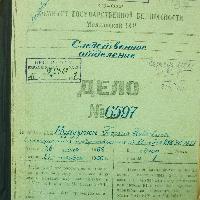Gediminas Ilgūnas was a well-known Lithuanian writer, journalist, ethnographer and traveller. In the 1950s, he was accused of anti-Soviet activity and imprisoned. On being released from prison, he and his close friends started to organise ethnographic expeditions, collecting material about important personalities in Lithuanian national history. The collection holds various manuscripts, including documents relating to his activities in the Sąjūdis movement and his political activities as a member of the Supreme Council, short memories about the Stalinist period, and material collected for a biography of Vincas Pietaris. The collection shows the actions of a Soviet-period cultural activist who tried to collect and preserve Lithuania's past culture.
-
Asukoht:
-
10102 Vilnius O. Milašiaus gatvė 19 , Lithuania
-
Teemad:
-
Asutamiskuupäev:
-
Tähtteos:
The collection reflects the activity of the architect Gheorghe Leahu, known in Romania for his watercolours representing streets and monuments of Bucharest destroyed as a result of the “urban systematisation” policy of Ceauşescu’s regime. The Gheorghe Leahu Collection includes watercolours, drawings, manuscripts, letters, photographs, and books.
-
Asukoht:
-
București Bulevardul Libertății 12, Romania 030167
-
Teemad:
-
Asutamiskuupäev:
-
Tähtteos:
This collection focuses on the case of Gheorghe Muruziuc, a person of working-class background who expressed his opposition to the Soviet regime by raising the Romanian flag on the factory where he worked, in June 1966. This was the first instance when the Romanian flag was displayed in the Moldavian Soviet Socialist Republic (MSSR) after June 1940.
-
Asukoht:
-
Chișinău Bulevardul Ștefan cel Mare și Sfînt 166, Moldova 2004
-
Teemad:
-
Asutamiskuupäev:
-
Tähtteos:
This ad-hoc collection was separated from the fonds of judicial files concerning persons subject to political repression during the communist regime which is currently stored in the Archive of the Intelligence and Security Service of the Republic of Moldova (formerly the KGB Archive). It focuses on the case of Gheorghe Zgherea, a person of peasant background who was a member of the Inochentist religious community, a millenarian and eschatological movement active in Bessarabia and Transnistria mostly during the first half of the twentieth century. The collection materials are revealing for the repressive policy of the Soviet regime in the religious sphere, showing the Soviet authorities’ hostile attitude toward non-mainstream and marginal denominations, which were perceived as a particularly serious threat. Zgherea, a preacher within his community starting from late 1950, was accused of “roaming the villages” of the Moldavian SSR and spreading “anti-Soviet ideas” among the local populace by “using their religious prejudices.” Arrested on 2 May 1953, he received a harsh sentence of twenty-five years of hard labour. His sentence was reduced to five years of hard labour in June 1955, when he was also amnestied according to a special decree of March 1953. Zgherea’s case thus points to the changing strategies of the regime applied after Stalin’s death, but also to the continuity of repression and to the shifting practices of stifling dissent in post-Stalinist Soviet society.
-
Asukoht:
-
Chișinău Bulevardul Ștefan cel Mare și Sfînt 166, Moldova 2004
-
Teemad:
-
Tähtteos:
Gino Hahnemann was an East German
Bohemian active in the independent literary, art, film, and most notably, LGBT communities of the 1980s. He contributed to the alternative milieu of the GDR as an author, photographer, set designer and filmmaker.
Hahnemann was one of the first and few authors in the GDR to openly write about private homosexual experiences. His estate is preserved by the Academy of Arts in Berlin.
-
Asukoht:
-
10115 Berlin Robert-Koch-Platz 10 , Germany
-
Teemad:
-
Asutamiskuupäev:
-
Tähtteos:





